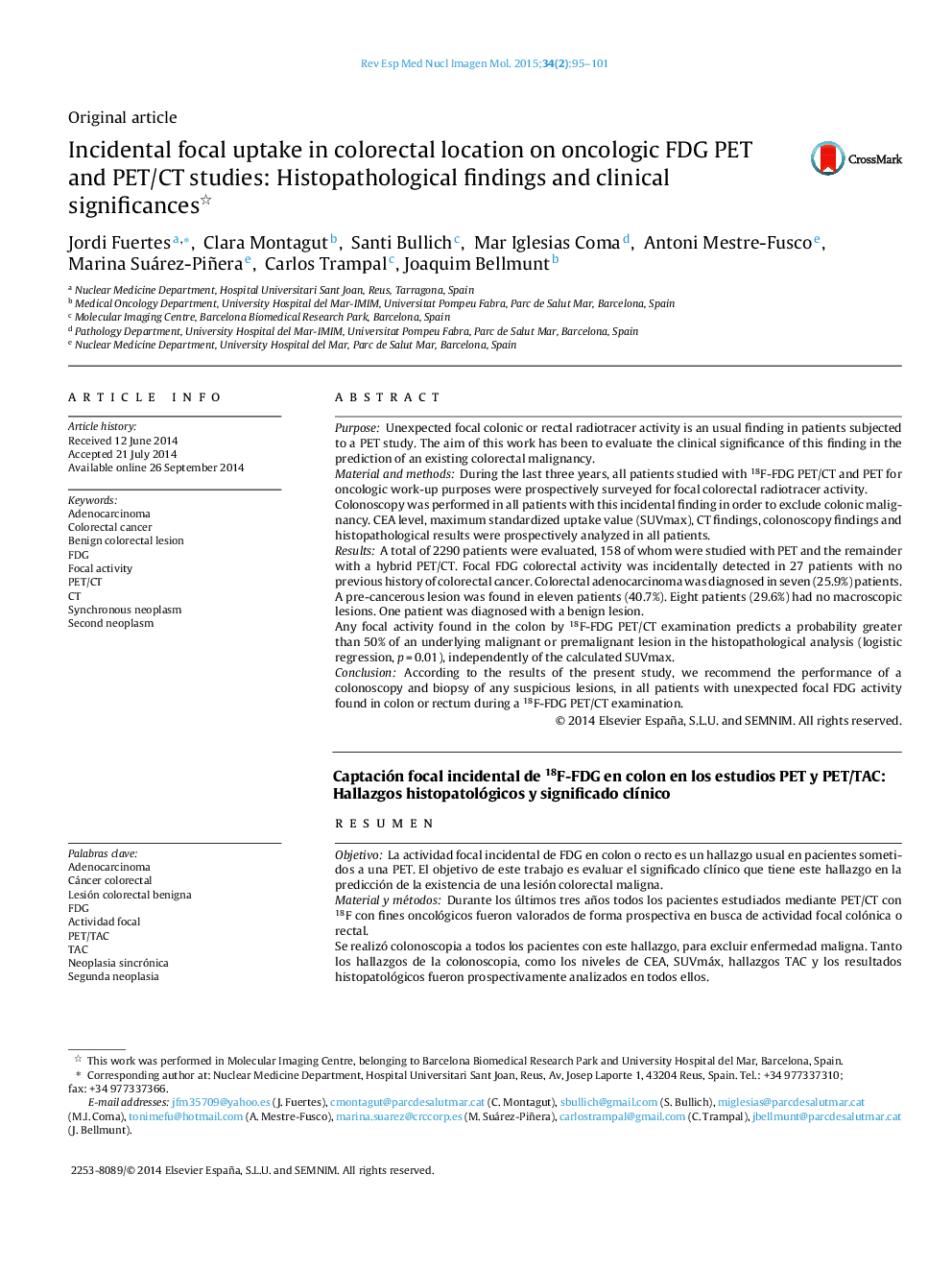| کد مقاله | کد نشریه | سال انتشار | مقاله انگلیسی | نسخه تمام متن |
|---|---|---|---|---|
| 4250279 | 1283897 | 2015 | 7 صفحه PDF | دانلود رایگان |

PurposeUnexpected focal colonic or rectal radiotracer activity is an usual finding in patients subjected to a PET study. The aim of this work has been to evaluate the clinical significance of this finding in the prediction of an existing colorectal malignancy.Material and methodsDuring the last three years, all patients studied with 18F-FDG PET/CT and PET for oncologic work-up purposes were prospectively surveyed for focal colorectal radiotracer activity.Colonoscopy was performed in all patients with this incidental finding in order to exclude colonic malignancy. CEA level, maximum standardized uptake value (SUVmax), CT findings, colonoscopy findings and histopathological results were prospectively analyzed in all patients.ResultsA total of 2290 patients were evaluated, 158 of whom were studied with PET and the remainder with a hybrid PET/CT. Focal FDG colorectal activity was incidentally detected in 27 patients with no previous history of colorectal cancer. Colorectal adenocarcinoma was diagnosed in seven (25.9%) patients. A pre-cancerous lesion was found in eleven patients (40.7%). Eight patients (29.6%) had no macroscopic lesions. One patient was diagnosed with a benign lesion.Any focal activity found in the colon by 18F-FDG PET/CT examination predicts a probability greater than 50% of an underlying malignant or premalignant lesion in the histopathological analysis (logistic regression, p = 0.01), independently of the calculated SUVmax.ConclusionAccording to the results of the present study, we recommend the performance of a colonoscopy and biopsy of any suspicious lesions, in all patients with unexpected focal FDG activity found in colon or rectum during a 18F-FDG PET/CT examination.
ResumenObjetivoLa actividad focal incidental de FDG en colon o recto es un hallazgo usual en pacientes sometidos a una PET. El objetivo de este trabajo es evaluar el significado clínico que tiene este hallazgo en la predicción de la existencia de una lesión colorectal maligna.Material y métodosDurante los últimos tres años todos los pacientes estudiados mediante PET/CT con 18F con fines oncológicos fueron valorados de forma prospectiva en busca de actividad focal colónica o rectal.Se realizó colonoscopia a todos los pacientes con este hallazgo, para excluir enfermedad maligna. Tanto los hallazgos de la colonoscopia, como los niveles de CEA, SUVmáx, hallazgos TAC y los resultados histopatológicos fueron prospectivamente analizados en todos ellos.ResultadosUn total de 2290 pacientes fueron evaluados, 158 de ellos fueron estudiados con PET y el resto con un equipo híbrido PET/TAC. En 27 de ellos se halló actividad focal de FDG sospechosa en colon o recto. En siete (25,9%) pacientes se diagnóstico adenocarcinoma colorectal. En 11 pacientes (40,7%) se halló una lesión precancerosa. Ocho pacientes (29,6%) no presentaron ninguna lesión macroscópicamente apreciable en la colonoscopia. Un paciente fue diagnosticado de una lesión benigna.Cualquier actividad focal de FDG predice una probabilidad mayor del 50% de corresponder a una lesión premaligna o maligna en el análisis histopatológico (regresión logística, p=0,01), independientemente del SUVmáx.ConclusiónDe acuerdo con los resultados del presente estudio recomendamos la realización de una colonoscopia y biopsia de cualquier lesión sospechosa en todos los pacientes en los que se observe actividad focal de FDG en colon o recto en los estudios PET/TAC.
Journal: Revista Española de Medicina Nuclear e Imagen Molecular (English Edition) - Volume 34, Issue 2, March–April 2015, Pages 95–101